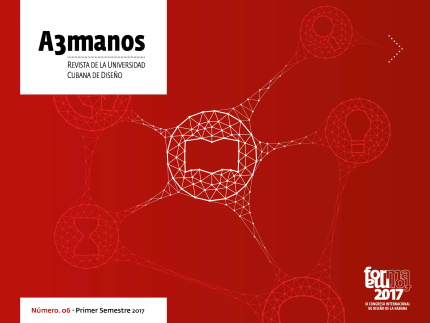Typographical competences: A formative proposal to be, to know and to know how to do.
##plugins.themes.bootstrap3.article.main##
Abstract
The formative approach for professional competences has been researched at the Higher Institute of Design, both at the general curriculum level and in specific areas of careers. The main objective of this paper is to propose the typographical competences that should be formed in the Cuban design student, considering the new 4-year training context and the cur-rent demands of the Cuban reality. To achieve the result, based on methods and techniques such as analysis-synthesis, deduction-induction, documentary analysis, structured observation and questionnaires, the theoretical and conceptual referents on the subject are systematized. A diagnosis of typographic training is also carried out at ISDi, where correct and incorrect results are obtained and an important group of study variables are identified. Finally, a proposal of typographical competences is elaborated, whose structure considers the historical component and the integration of semantic, syntactic and pragmatic dimensions to effectively develop professional problems that demand the use of typography. The result considers both the knowledge and the skills necessary for the formation of the subject, without detracting from the axiological component and the acquired trade through practical experience in the design action.
##plugins.themes.bootstrap3.article.details##

This work is licensed under a Creative Commons Attribution-NonCommercial-ShareAlike 4.0 International License.
- Attribution — You must give appropriate credit , provide a link to the license, and indicate if changes were made . You may do so in any reasonable manner, but not in any way that suggests the licensor endorses you or your use.
- NonCommercial — You may not use the material for commercial purposes .
- No additional restrictions — You may not apply legal terms or technological measures that legally restrict others from doing anything the license permits.
- ShareAlike — If you remix, transform, or build upon the material, you must distribute your contribution under the same license as the original. NOTE: This point applies to numbers 1 to 20 of the magazine with the previous CC-BY-NC-SA 4.0 license. Does not apply to the new CC BY-NC 4.0 license from Volume 11, Number. 21 (2024).
References
PEÑA, S. (2008). Propuesta de currículo para la formación de diseñadores. La Habana, Cuba. Instituto Superior de Diseño (ISDi).
VALLE E. (2011). Propuesta de competencias profesionales específicas relacionadas con el dominio de los recursos formales para el diseño. La Habana, Cuba. Instituto Superior de Diseño (ISDI).
RAMÍREZ, J. (2011). Las competencias profesionales específicas para proyectar en el diseño industrial. La Habana, Cuba. Instituto Superior de Diseño (ISDi).
NAVARRO, E. (2014). Elementos de competencias a desarrollar en estudiantes de diseño a través de la enseñanza de los materiales y procesos. La Habana, Cuba. Instituto Superior de Diseño (ISDi).
CASTRO, O. (2014). Sistema de competencias profesionales específicas requeridas para el diseño de videojuegos. La Habana, Cuba. Instituto Superior de Diseño (ISDi).
PEÑA, S. (2014). “Conferencias de gestión del Diseño Industrial”. Maestría en Gestión del Diseño. La Habana, Cuba. Instituto Superior de Diseño (ISDi).
GRANT, Y. (2011). Propuesta de competencias profesionales para la carrera de periodismo. Holguín, Cuba. Universidad de Holguín.
ZABALZA M. (2003). Competencias docentes del profesorado universitario. Madrid. Narcea.
RIVERA, L. Desarrollo de las competencias argumentativas en el taller de diseño. Xochimilco. México. Universidad Autónoma Metropolitana (UAM).
CÁTEDRA FONTANA. (1996). Pensamiento tipográfico. Argentina. Edicial S.A.
FONTANA, R. (2012). Ganarse la letra. México. Colección Antologías. Programa Editorial de la División de Ciencias y Artes para el Diseño. Universidad Autónoma Metropolitana. Unidad Xochimilco.
GÁLVEZ F. (2004). Educación tipográfica: una introducción a la tipografía. Santiago de Chile. Universidad Diego Portales.
POHLEN, J. (2011). Fuente de letras. Taschen. Edición española.
MESEGUER, L., HENESTROSA, C., SCAGLIONE, J. (2012). Cómo crear tipografías. Tipo E Editorial.
SMEIJERS, F. (1996) Counterpunch. Making type in the sixteenth century, designing typefaces now. Londres. Hyphen Press.
ARES, F. (2013). El dominio de las letras: los diseñadores y la producción, elección y uso de signos tipográficos. Argentina. Universidad Nacional de La Plata.






















